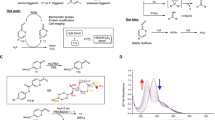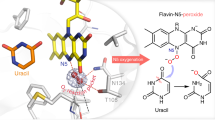Abstract
The current perspective holds that the generation of secondary signaling mediators from nitrite (NO2−) requires acidification to nitrous acid (HNO2) or metal catalysis. Herein, the use of stable isotope–labeled NO2− and LC-MS/MS analysis of products reveals that NO2− also participates in fatty acid nitration and thiol S-nitrosation at neutral pH. These reactions occur in the absence of metal centers and are stimulated by autoxidation of nitric oxide (•NO) via the formation of symmetrical dinitrogen trioxide (nitrous anhydride, symN2O3). Although theoretical models have predicted physiological symN2O3 formation, its generation is now demonstrated in aqueous reaction systems, cell models and in vivo, with the concerted reactions of •NO and NO2− shown to be critical for symN2O3 formation. These results reveal new mechanisms underlying the NO2− propagation of •NO signaling and the regulation of both biomolecule function and signaling network activity via NO2−-dependent nitrosation and nitration reactions.
This is a preview of subscription content, access via your institution
Access options
Subscribe to this journal
Receive 12 print issues and online access
$259.00 per year
only $21.58 per issue
Buy this article
- Purchase on Springer Link
- Instant access to full article PDF
Prices may be subject to local taxes which are calculated during checkout






Similar content being viewed by others
References
Maron, B.A., Tang, S.S. & Loscalzo, J. S-nitrosothiols and the S-nitrosoproteome of the cardiovascular system. Antioxid. Redox Signal. 18, 270–287 (2013).
Bosworth, C.A., Toledo, J.C. Jr., Zmijewski, J.W., Li, Q. & Lancaster, J.R. Jr. Dinitrosyliron complexes and the mechanism(s) of cellular protein nitrosothiol formation from nitric oxide. Proc. Natl. Acad. Sci. USA 106, 4671–4676 (2009).
Lancaster, J.R. Jr. Protein cysteine thiol nitrosation: maker or marker of reactive nitrogen species-induced nonerythroid cellular signaling? Nitric Oxide 19, 68–72 (2008).
Möller, M.N. et al. Membrane “lens” effect: focusing the formation of reactive nitrogen oxides from the *NO/O2 reaction. Chem. Res. Toxicol. 20, 709–714 (2007).
Nedospasov, A.A. Is N2O3 the main nitrosating intermediate in aerated nitric oxide (NO) solutions in vivo? If so, where, when, and which one? J. Biochem. Mol. Toxicol. 16, 109–120 (2002).
Broniowska, K.A., Keszler, A., Basu, S., Kim-Shapiro, D.B. & Hogg, N. Cytochrome c-mediated formation of S-nitrosothiol in cells. Biochem. J. 442, 191–197 (2012).
Souza, J.M., Peluffo, G. & Radi, R. Protein tyrosine nitration—functional alteration or just a biomarker? Free Radic. Biol. Med. 45, 357–366 (2008).
Akaike, T., Nishida, M. & Fujii, S. Regulation of redox signalling by an electrophilic cyclic nucleotide. J. Biochem. 153, 131–138 (2013).
Delmastro-Greenwood, M., Freeman, B.A. & Wendell, S.G. Redox-dependent anti-inflammatory signaling actions of unsaturated Fatty acids. Annu. Rev. Physiol. 76, 79–105 (2014).
Schopfer, F.J., Cipollina, C. & Freeman, B.A. Formation and signaling actions of electrophilic lipids. Chem. Rev. 111, 5997–6021 (2011).
Bonacci, G. et al. Conjugated linoleic acid is a preferential substrate for fatty acid nitration. J. Biol. Chem. 287, 44071–44082 (2012).
Salvatore, S.R. et al. Characterization and quantification of endogenous fatty acid nitroalkene metabolites in human urine. J. Lipid Res. 54, 1998–2009 (2013).
Charles, R.L. et al. Protection from hypertension in mice by the Mediterranean diet is mediated by nitro fatty acid inhibition of soluble epoxide hydrolase. Proc. Natl. Acad. Sci. USA 111, 8167–8172 (2014).
Lundberg, J.O. & Weitzberg, E. Biology of nitrogen oxides in the gastrointestinal tract. Gut 62, 616–629 (2013).
Goldstein, S. & Czapski, G. Kinetics of nitric oxide autoxidation in aqueous solution in the absence and presence of various reductants—the nature of the oxidizing intermediates. J. Am. Chem. Soc. 117, 12078–12084 (1995).
Wink, D.A., Darbyshire, J.F., Nims, R.W., Saavedra, J.E. & Ford, P.C. Reactions of the bioregulatory agent nitric oxide in oxygenated aqueous media: determination of the kinetics for oxidation and nitrosation by intermediates generated in the NO/O2 reaction. Chem. Res. Toxicol. 6, 23–27 (1993).
van Faassen, E.E. et al. Nitrite as regulator of hypoxic signaling in mammalian physiology. Med. Res. Rev. 29, 683–741 (2009).
van der Vliet, A., Eiserich, J.P., Halliwell, B. & Cross, C.E. Formation of reactive nitrogen species during peroxidase-catalyzed oxidation of nitrite. A potential additional mechanism of nitric oxide-dependent toxicity. J. Biol. Chem. 272, 7617–7625 (1997).
Ford, P.C. Reactions of NO and nitrite with heme models and proteins. Inorg. Chem. 49, 6226–6239 (2010).
Castro, L., Eiserich, J.P., Sweeney, S., Radi, R. & Freeman, B.A. Cytochrome c: a catalyst and target of nitrite-hydrogen peroxide-dependent protein nitration. Arch. Biochem. Biophys. 421, 99–107 (2004).
d'Ischia, M., Napolitano, A., Manini, P. & Panzella, L. Secondary targets of nitrite-derived reactive nitrogen species: nitrosation/nitration pathways, antioxidant defense mechanisms and toxicological implications. Chem. Res. Toxicol. 24, 2071–2092 (2011).
Goldstein, S. & Czapski, G. Mechanism of the nitrosation of thiols and amines by oxygenated•NO solutions: the nature of the nitrosating intermediates. J. Am. Chem. Soc. 118, 3419–3425 (1996).
Basu, S. et al. Catalytic generation of N2O3 by the concerted nitrite reductase and anhydrase activity of hemoglobin. Nat. Chem. Biol. 3, 785–794 (2007).
Fernandez, B.O. & Ford, P.C. Nitrite catalyzes ferriheme protein reductive nitrosylation. J. Am. Chem. Soc. 125, 10510–10511 (2003).
Tejero, J. et al. Low NO concentration dependence of reductive nitrosylation reaction of hemoglobin. J. Biol. Chem. 287, 18262–18274 (2012).
Beckman, J.S. et al. Kinetics of superoxide dismutase- and iron-catalyzed nitration of phenolics by peroxynitrite. Arch. Biochem. Biophys. 298, 438–445 (1992).
Ischiropoulos, H. et al. Peroxynitrite-mediated tyrosine nitration catalyzed by superoxide dismutase. Arch. Biochem. Biophys. 298, 431–437 (1992).
Duranski, M.R. et al. Cytoprotective effects of nitrite during in vivo ischemia-reperfusion of the heart and liver. J. Clin. Invest. 115, 1232–1240 (2005).
Bonczynski, J.J., Ludwig, L.L., Barton, L.J., Loar, A. & Peterson, M.E. Comparison of peritoneal fluid and peripheral blood pH, bicarbonate, glucose, and lactate concentration as a diagnostic tool for septic peritonitis in dogs and cats. Vet. Surg. 32, 161–166 (2003).
Sennesael, J.J., De Smedt, G.C., Van der Niepen, P. & Verbeelen, D.L. The impact of peritonitis on peritoneal and systemic acid-base status of patients on continuous ambulatory peritoneal dialysis. Perit. Dial. Int. 14, 61–65 (1994).
Vitturi, D.A. & Patel, R.P. Current perspectives and challenges in understanding the role of nitrite as an integral player in nitric oxide biology and therapy. Free Radic. Biol. Med. 51, 805–812 (2011).
Kansanen, E., Jyrkkanen, H.K. & Levonen, A.L. Activation of stress signaling pathways by electrophilic oxidized and nitrated lipids. Free Radic. Biol. Med. 52, 973–982 (2012).
Horakh, J., Borrmann, H. & Simon, A. Phase relationships in the N2O3/N2O4 system and crystal structures of N2O3 . Chemistry 1, 389–393 (1995).
Fateley, W.G., Bent, H.A. & Crawford, B. Infrared spectra of the frozen oxides of nitrogen. J. Chem. Phys. 31, 204–217 (1959).
Holland, R.F. & Maier, W.B. Infrared absorption spectra of nitrogen oxides in liquid xenon. Isomerization of N2O3a). J. Chem. Phys. 78, 2928–2941 (1983).
Varetti, E.L. & Pimentel, G.C. Isomeric forms of dinitrogen trioxide in a nitrogen matrix. J. Chem. Phys. 55, 3813–3821 (1971).
Shaw, A.W. & Vosper, A.J. Dinitrogen trioxide. Part IX. Stability of dinitrogen trioxide in solution. J. Chem. Soc. A 1971, 1592–1595 (1971).
Jubert, A.H., Varetti, E.L., Villar, H.O. & Castro, E.A. A theoretical study of the relative stability of the isomeric forms of N2O3 . Theor. Chim. Acta 64, 313–316 (1984).
Sun, Z., Liu, Y.D., Lv, C.L. & Zhong, R.G. Theoretical investigation of the isomerization of N2O3 and the N-nitrosation of dimethylamine by asym-N2O3, sym-N2O3, and trans–cis N2O3 isomers. J. Mol. Struct. Theochem 908, 107–113 (2009).
Zakharov, I.I. & Zakharova, O.I. Nitrosonium nitrite isomer of N2O3: quantum-chemical data. J. Struct. Chem. 50, 212–218 (2009).
Pryor, W.A., Lightsey, J.W. & Church, D.F. Reaction of nitrogen dioxide with alkenes and polyunsaturated fatty acids: addition and hydrogen-abstraction mechanisms. J. Am. Chem. Soc. 104, 6685–6692 (1982).
Wink, D.A. et al. Reaction kinetics for nitrosation of cysteine and glutathione in aerobic nitric oxide solutions at neutral pH. Insights into the fate and physiological effects of intermediates generated in the NO/O2 reaction. Chem. Res. Toxicol. 7, 519–525 (1994).
Wink, D.A. & Ford, P.C. Nitric oxide reactions important to biological systems: a survey of some kinetics investigations. Methods 7, 14–20 (1995).
Huie, R.E. The reaction kinetics of NO2 . Toxicology 89, 193–216 (1994).
Galliker, B., Kissner, R., Nauser, T. & Koppenol, W.H. Intermediates in the autoxidation of nitrogen monoxide. Chemistry 15, 6161–6168 (2009).
Amatore, C. et al. Characterization of the electrochemical oxidation of peroxynitrite: relevance to oxidative stress bursts measured at the single cell level. Chemistry 7, 4171–4179 (2001).
Koppenol, W.H. Nitrosation, thiols, and hemoglobin: energetics and kinetics. Inorg. Chem. 51, 5637–5641 (2012).
Pacher, P., Beckman, J.S. & Liaudet, L. Nitric oxide and peroxynitrite in health and disease. Physiol. Rev. 87, 315–424 (2007).
Woodcock, S.R., Bonacci, G., Gelhaus, S.L. & Schopfer, F.J. Nitrated fatty acids: synthesis and measurement. Free Radic. Biol. Med. 59, 14–26 (2013).
Lang, J.D. Jr. et al. Inhaled NO accelerates restoration of liver function in adults following orthotopic liver transplantation. J. Clin. Invest. 117, 2583–2591 (2007).
Acknowledgements
This study was supported by US National Institutes of Health grants R01-HL058115, R01-HL64937, P01-HL103455 (B.A.F.), R01-AT006822 (F.J.S.) and AHA #14GRNT20170024 (F.J.S.). We thank M.T. Gladwin, J. Tejero, A.M. Ferreira and B. Alvarez for helpful discussions and T. Sparwasser for expert assistance with flow cytometry experiments.
Author information
Authors and Affiliations
Contributions
D.A.V. designed, performed and analyzed experiments, and wrote the manuscript. L.M. designed, performed and analyzed cell-based experiments. S.R.S. performed high-resolution LC-MS/MS experiments and contributed to overall LC-MS/MS method development. E.M.P. designed and performed •NO2 gas experiments. M.F. developed extraction methods for in vivo experiments. G.F.-S. contributed to data interpretation. J.R.L. designed experiments, contributed to data interpretation and provided critical insight into manuscript content. B.A.F. contributed to the overall concept, experimental design and manuscript preparation. F.J.S. designed experiments and contributed to data analysis and interpretation as well as manuscript writing.
Corresponding authors
Ethics declarations
Competing interests
B.A.F. and F.J.S. acknowledge financial interest in Complexa, Inc.
Supplementary information
Supplementary Text and Figures
Supplementary Results, Supplementary Figures 1–10 and Supplementary Tables 1 and 2 (PDF 4444 kb)
Rights and permissions
About this article
Cite this article
Vitturi, D., Minarrieta, L., Salvatore, S. et al. Convergence of biological nitration and nitrosation via symmetrical nitrous anhydride. Nat Chem Biol 11, 504–510 (2015). https://doi.org/10.1038/nchembio.1814
Received:
Accepted:
Published:
Issue Date:
DOI: https://doi.org/10.1038/nchembio.1814
This article is cited by
-
Nitro-fatty acids decrease type I interferons and monocyte chemoattractant protein 1 in ex vivo models of inflammatory arthritis
BMC Immunology (2021)
-
Nitro-fatty acids: electrophilic signaling molecules in plant physiology
Planta (2021)
-
An N-nitrosating metalloenzyme constructs the pharmacophore of streptozotocin
Nature (2019)
-
STING palmitoylation as a therapeutic target
Cellular & Molecular Immunology (2019)
-
Electrophilic fatty acid nitroalkenes regulate Nrf2 and NF-κB signaling:A medicinal chemistry investigation of structure-function relationships
Scientific Reports (2018)



